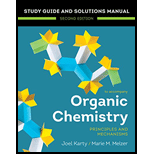
Concept explainers
Interpretation:
The appropriate precursors to the given target, by applying a transform that undoes the reaction in entry 2 of Table 13-1, are to be drawn.
Concept introduction:
Synthesis may be designed by thinking in the reverse direction, from the product to the starting compound, in a method called retrosynthesis. Retrosynthesis involves starting with the product and determining a suitable precursor from which it can be synthesized, without considering specific reactions. The precursor must be a simpler molecule, which may or may not have a close structural relation to the target molecule. This process is repeated until an easily available (or easily prepared) precursor is reached. Each of these steps is called a transform. The reaction in entry 2 in Table 13-1 suggests that the terminal
Want to see the full answer?
Check out a sample textbook solution
Chapter 13 Solutions
Organic Chemistry: Principles And Mechanisms: Study Guide/solutions Manual (second)
- Write down major r producto), or other recietent6) and/or fallawine the reactionconditions for the Ht Na BH (OAC)S +(CH2)2NH 1. CH3 CH2 Mg Br 2. H30+ CH2CN CH30 OEt 1.NaOH, tho A 2. H3ot 3. Aarrow_forwardI H Ph Br In an E2 elimination reaction, the leaving group and the hydrogen atom must be anti-coplanar for this concerted reaction to occur. ||| Identify which of the following structures has the hydrogen atom and the leaving group aligned anti-coplanar. CH3 Ph Ph H TI F H || OH H Ph H CH3 CH3 Br Ph Br A) I B) II C) IIIarrow_forwardthe following reaction mechanism contains mistakes. which of the following statements correctly describes the curved arrows consistent with the reaction?arrow_forward
- c. Snl reactions dominate under polar protic solvents. Increasing the polarity of the solvent will increase the rate of the reaction because the polar solvent will stabilize the dispersed charges on the transition state more than it will stabilize the neutral reactant. Label areas of ô* and & on the molecules of the transition state of the SN1 reaction below: Me Me Ме Me Me H20 Br -Br OH + НО \'H Et Et RDS Et H Et Et transition state not isolable carbocation intermediate not isolablearrow_forwardI ||| Br Br Predict the major product(s) of this radical halogenation reaction. Br₂ hv || IV Br Br racemic Screenshot A) I B) II C) III D) IVarrow_forwardDraw the product of the below reaction, a mechanism and a Molecular Orbital ergy diagram for it. Indicate which levels are used for the reaction. MeO2C hv (light) MeO₂Carrow_forward
- ps/assessment/take/launch.jsp?course_assessment_id%3D_10030_1&course_id%3D_58621_1&content_id%3D 221089 1&step= Remaining Time: 46 minutes, 58 seconds. * Question Completion Status: O Rearrangement reaction. QUESTION 13 The AG° (free energy change) for the conversion of A to B is predicted to be which of the following? CI OOH2 H20 + CI CI H-CI step 1 A step 2 step 3 B O AG° = 0 O AG° 0 O Cannot be determined from the information provided O It can be determine from the type of reaction QUESTION 14 Save All Answers Click Save and Submit to save and submit. Click Saue All Answers to save all answers. 19°C Type here to search 近arrow_forwardThe following reaction, which converts a cyclic ether into a diol, is discussed in Chapter 8. It consists of the three elementary (i) ©OH2 H + H2O steps shown. For each step (i–iii), (a) identify all electron-rich sites and all electron-poor sites, (b) draw in the appropriate curved arrows to (ii) show the bond formation and bond breaking that occur, and (c) name the elementary step. + H20 НО OH, (iii) НО .H + H2O НО ОН H %23arrow_forwardPart A Draw a reasonable mechanism for this reaction. Interactive 3D display mode Ph Ph -P=CH, CH2 Ph Edit the reaction by drawing all steps in the appropriate boxes and connecting them with reaction arrows. Add charges where needed. Electron flow arrows should start on an atom or a bond and should end on an atom, bond, or location where a new bond should be created. D 5 C Q Q Q H x" iim H CI Br P F P Pearsonarrow_forward
- For the following proton-transfer reaction, identify the correct curved arrow mechanism. 11 III IV V OI O II O III №-H + H₂N 17 H₂N H₂N H₂N H₂N ->>> tv H H + H3Narrow_forwardPlastic photochromic sunglasses are based on the following reversible rearrangement of a dye inside the lenses that occurs when the lenses are exposed to sunlight. The original dye absorbs UV light but not visible light and is thus colorless, while the rearrangement product absorbs visible light and is thus darkened. (a) Show the mechanism of the rearrangement. (b) Why does the rearrangement product absorb at a longer wavelength (visible light) than the original dye (UV)?arrow_forwardProvide a step-wise solution for the synthesis problem below: Available Reactant HO Synthesis Target .OH Hint #1: The correct answer includes one new Chapter 19 reaction and one new Chapter 20 reaction Hint #2: Look out for strategies that lead to "dead ends" due to selectivity of reactions!arrow_forward
 Organic Chemistry: A Guided InquiryChemistryISBN:9780618974122Author:Andrei StraumanisPublisher:Cengage Learning
Organic Chemistry: A Guided InquiryChemistryISBN:9780618974122Author:Andrei StraumanisPublisher:Cengage Learning

